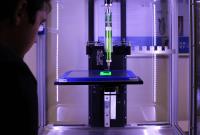 Add My Company
Add My Company
Sign In

3D scanning has come a long way. However, some might say 3D scanning currently holds a similar place in the design realm that 3D printing did in its infancy. This just means that in the future, 3D scanning will only become more powerful, more useful, and more affordable, influencing a huge array of industries.
As an industry itself, 3D scanning is predicted to grow at an annual compounded growth rate of 9.6% until 2022, according to a report from MarketsandMarkets. The report says this increase is largely driven by the rapid pace of development in 3D scanner technology and the growing adoption of scanners for quality assurance and control. But what could this future look like?
QUALITY CONTROL
A quality control team is only as good as the tools they have to work with. 3D scanning technologies have become an essential part of quality control operations within industrial settings. They capture the geometry of single objects, and the data collected can be used for 3D printing or model manipulation for a range of tasks including product design, product production, or simply accurate measurements.
Handheld 3D scanners quickly became the industry standard. They allow for precise measurement with consistently accurate readings. Automating quality control with the use of robotic arms has allowed for a reduction in human error and labour hours, saving businesses money and increasing flexibility for quality control teams.
FUTURE EXPECTATIONS
It’s likely that as 3D scanning becomes more popular, it will make the design process more efficient, improving accuracy and reducing the need for reworks. You can create multiple versions of the same design using modelling, meaning there is no need to create the design until you’re satisfied with it.
3D scanning will also open the doors for businesses to maximise their investments. By combining AI and 3D scanning, computers will be able to make decisions based on specific criteria, often about things unseen to the human eye. For example, this could help manufacturers decide whether a dent in an aircraft requires immediate attention or whether it’s a non-issue for the time being. With more industries adopting the technology, the influence on quality control will grow.
3D technology is also providing ways for museums to analyse the internal structure of objects without damaging them. This provides bigger learning opportunities to the customers and for professionals seeking new information in their chosen field. It can also aid in the 3D printing of accurate models for display when displaying original artefacts is too risky or not possible. For example, insects and other biological organisms.
3D printing is also developing rapidly. While it has made huge developments in fields such as medicine, it’s likely that more complex 3D printers will make their way into homes, businesses, disaster sites, and even outer space. It’s also been described as the future of factories.
So, as we approach 2020 and beyond, 3D scanning is only going to become more essential in the day-to-day operations of many sectors. What is most exciting is the advancement of the technology, which will only continue to push the boundaries of fidelity. And we can’t wait to see it.
For more information on What does the future hold for 3D scanning and printing? talk to Central Scanning Ltd
Enquire Now
List your company on FindTheNeedle.

